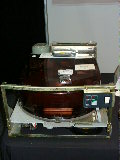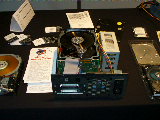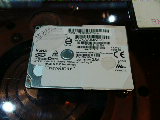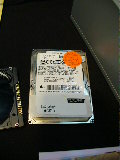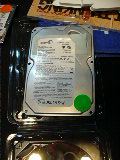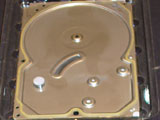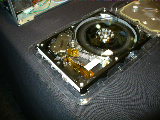 Specialist Data Recovery firm educates trade show visitors the real dangers of failing Hard Disc Drives/Digital storage with real-world samples and best practice to avoid data loss.
Specialist Data Recovery firm educates trade show visitors the real dangers of failing Hard Disc Drives/Digital storage with real-world samples and best practice to avoid data loss.
CeBIT Australia 2008 Special Report
One would think that at a globally recognised IT trade show amongst all the Web 2.0 start-ups, Military/Enterprise data link vendors, research institutes, foreign diplomats and Channel distributors one would find an exhibitor who focused solely on something as important, ubiquitous and commonplace as a magnetic hard drive?
Casual users of computing with little to no IT knowledge even know what a hard drive is, even if it is in the transposed sense of the PC system chassis being the ‘hard drive or hard disk’.
The market leaders such as Seagate, Western Digital, Samsung and Hitachi Global Storage do not bother with ‘business’ oriented trade shows such as CeBIT any more (at least in their international, regional versions) as everyone and anyone needs a Hard Disk Drive and there is little convincing of purchasers about this matter.
These Vendors make the hard drives by the millions each month and will gladly sell you a newer, larger capacity disk drive to replace a user’s failed drive.
Amongst walking the halls of CeBIT this time around, we came across, only just, a Sydney based data recovery firm who had real world examples of significant types and generations of Hard Disk Drives as well as common models of Hard Disk Drives which have known issues which lead to failure of the drive, as well as drives have just failed out of use or poor operating environments. In other words, rather than try to explain a complex topic to a person, just show them real thing which speaks more than just pictures and words.
The fact that this firm bothered to bring along these drives as case-studies and the staff’s willingness to discuss and explain difficult or problematic drive models impressed us, when they (or other firms) could have simply displayed a video or PowerPoint presentation or even just a single broken drive as a paperweight. Considering that revealing or discussing their day to day work on different drives (and making users proactive in the process) could actually lead to loss of business.
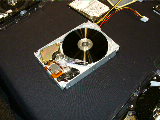
Quantum SCSI drive in Self-Test mode, demonstrating the head mechanism performing seek operations.
The Firm, XYBER Data Recovery of Sydney also had some ‘antique’ Hard Disk Drives on display dating back from 1986 as well as some more contemporary but less common models E.g. Compact sized 1.8” hard disks all with their covers removed for inspection by visitors to their stand or display of visible damage to the hard disk platter, the medium that stores a user’s data.
NitroWare.net spoke at length with representatives of this firm regarding typical symptoms of failing drives, problematic brands and models, strategy and best practice for users to preserve their precious data as well as challenges and issues faced with use and recovery of flash media such as USB flash drives/keys/sticks - a digital storage format that is growing exponentially in recent years.
We were pleased that the firm took a neutral view towards drive vendors and agreeing that all drives are equally likely to fail in their own ways. This view is not equally shared by the industry and user community alike and is a common subject of debate and conflict in online discussion.
Since data recovery firms in general see all types of brands, models and failures on a daily basis and have to work with the drives at the lowest level, a good reputable firm will know the ‘ins and outs’ of each brand and should not be particularly biased towards a particular vendor of disk drive.
As hard disk platter capacity increases, the capacity of the hard disk itself meaning vendors can squeeze more data into their traditional form factors? At time of going to press, Western Digital has announced their migration to 334 Gigabytes per platter. A typical Hard Disk Drive may comprise of a number of internal disks, between one and four which each disk (platter) comprising of the 334 Gigabytes.
What this means is that Hard Disk Drive vendors can lower their production costs by using higher areal density and reduce the amount of physical raw material needed to make the drive resulting in lower prices for the consumer which as low as $100 AUD for 500 gigabytes or $115 for 750 gigabytes, verified by NitroWare.net as of May 2008.
Vendors now offer three to five year warranties on these Hard Disk Drives but this typically means that the user will receive a ‘certified refurbished drive’ as a replacement and not a brand new drive as it is a more economic solution for the vendor as the price per drive has lowered.
For some segments of users and resellers this does not pose a problem but for others it does.
A fellow Australian based Corporate owned Enthusiast Computing publication commented in their online coverage of CeBIT that they challenged this firm on whether or not a clean room is needed for data recovery.
Well you need not wait for their coverage as we can answer this one now.
If it is a hardware fault with the drive, data recovery firms are able to interface with the drive using vendor provided tools or third tools and are able to correct issues such as repair or modify the drive geometry information, repair corrupt drive firmware, recover the firmware or update contents of firmware such as the drive firmware.
The next tier is if the drive’s electronics, mechanism, firmware and configuration are sound and healthy there are software tools that operate on the sectors of the drive to actually attempt recover data.
With disk file systems, deleted, lost or corrupt data can generally be recovered as when data is deleted, the data is actually not physically overwritten or erased. The pointers to a particular file in an index are deleted or marked as available.
Recovery tools, or if necessary manually editing the indexes on the drive will re-synchronise the drive contents and the drive index. Recovery firms typically have to operate at the sector level to repair damaged cause by system maintenance tools or attempts to recover the drive.
If the index and its backup copies is completely lost, then longer process is needed to recover a users files, this process which will pick up the data chunks and save them will end up with thousands of sequentially, or randomly named files which are meaningless to the user without analysing the file ‘headers’ to determine what type of the file the randomly named file is.
Some users may have noticed such behaviour when running system maintenance tools on a Windows or Unix disk partition.
Flash memory poses its own problems with sector level recovery. Each vendor of the actual semiconductors in the flash device, the controller chip which carries out all the requested instructions to read and write data into the device typically have their own proprietary algorithm in the way they map out and writ to areas of the flash memory.
In flash memory, data is not written sequentially as this will literately burn out the particular location in the integrated circuit just as if attempting to write to the same place on a piece of paper will tear a hole through the paper. The method to avoid is happening is called write leveling and each vendor has their own method of achieving this in their flash based storage products.
Not being able to see how the data is allocated poses a challenge to data recovery specialists as they would not know where to look next when trying to manually recover some data, just as if you have a map or a set of instructions which are missing some particular instructions or directions.
Historic Hard Disk Drives - Fujitsu, NEC and Seagate
This ‘Godzilla’ of a drive is a 1986 example of a enterprise grade mainframe hard disk from Fujitsu. While the translucent cover may seem unusual this is not the only differentiating factor from a classic hard disk.
This particular ‘drive’ incorporated multiple heads, side by side on the end of the arms which support these read write heads in a ‘H’ pattern.
A typical Hard Disk Drive has only a single set of heads at the tip of the arms and these arms resemble an ‘A’ pattern as per our photos.
This 1988 NEC hard disk uses a stepper motor as an actuator device to position the heads.
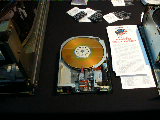
Stepper motors are large, bulky, noise and consume a lot of power and this technology has been replaced by voice coil motors/actuators such as is what is found in an audio speaker.
A Full-height Seagate SCSI hard disk in a is now an old external SCSI enclosure.
While computer users are familiar with form factor terminology such as 3.5” or 5.25”, what has disappeared due to progress and modernisation is the designation of height.
The form factors of drives we have known since the mid 1990s till present is what is known as half-height. Older devices could still comply to 3.5” or 5.25” width but would require double-height slot or bay to accommodate the drive.
This Seagate ST4702N is a 5.25” Full Height SCSI 600 Megabyte Hard Disk Drive form which is an example of the largest form factor available to traditional desktop PC, except here we have it inside an external SCSI enclosure. This drive was also an early example (1990) of voice coil motor technology instead of stepping motors.
The difference in size is most evident when comparing the entire unit to the adjacent 45GB IBM 3.5” Hard Disk Drive and the 5.25 HDD lid itself to the adjacent IBM Travelstar.
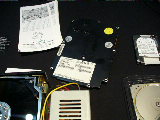
Modern Hard Disk Drives - Hitachi Travelstar 1.8” and 2.5”
1.8” Hard Disk Drives represent the smallest mass produced form factor of a traditional Hard Disk Drive to-date and are used in thin-and-light notebook computers and consumer electronics devices.
Only the Microdrive form factor is smaller but these have remained niche products, mainly for use in digital cameras, PDA or industrial electronics.
This 2005 example from Hitachi Storage, a Travelstar C4K60 with 30 gigabytes capacity shows how far technology has come to reduce the size of hard disks from the 1986 Fujitsu example. The entire Hard Disk Drive is smaller than the spindle hub on the Fujitsu drive !
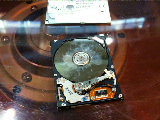
Excluding the fingerprints, there is visible damage to the disk platter. Of significance are the power requirements for this particular drive
- 0.08 watts in standby mode
- 0.25 watts when the drive is idle
- 1.4 watts when the drive is powering up
The power consumption of drives in this form factor is alike to a typical microprocessor in a consumer device and ten times less than a typical desktop 3.5” Hard Disk Drive.
A more common example of an Hitachi Travelstar 80GN with 60GB capacity is an example in the 2.5” form factor from 2003.
This particular drive, model IC25N060A was sourced from an Apple Macintosh computer as evident by the logo marking on the drive label which is present on all OEM drives supplied to Apple Computer so that company can validate a drive for warranty purposes.
Users who have had some experience with a failing disk drive may have had a similar experience to the issues that affect this drive in the question which does not pass its self tests on start-up and makes itself ready for use , due to faulty disk drive heads.
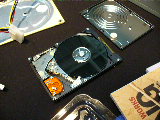
The beveled grooves in the drive lid are to maintain airflow when the drive is operation and also of note is how close the platter are to edge of the hard disk chassis, there is not much separation which is why smaller form factor disk drives require more shock protection in systems which they are used , typically notebook computers.
Modern Hard Disk Drives – Seagate Barracuda 7200.9
Moving on to desktop Hard Disk Drives, as we discussed even relatively new disk drives do fail, and this why manufacturers warranties have increased, to ‘protect’ the consumer. This following drive has a 5 year warranty and was still under warranty before data recovery was attempted.
Here we have a 160 Gigabyte Seagate Barracuda 7200.9 from 2006, a very popular and common disk drive with D-I-Y computer enthusiasts, white box system builders and Original Equipment Manufacturers.
This drive, model ST3160212A failed because the read/write head dug into the disk platters and scratched the surface, in other words a head crash. The effect of the damage is worsened when we consider that the platter rotate at 7200 RPM.
Keen readers might wonder why the platter seems so low in the hard disk chassis compared to our other photos. Modern hard drives have much larger areal densities, packing more gigabytes into a single disk.
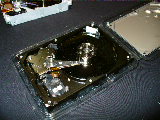
The 7200.9 model line uses a 160GB platter meaning only one disk platter is required whereas for the 80GB drive only one head and side of the double sided platter is used.This feature is why this particular drive has an ‘empty’ look
Modern Hard Disk Drives – IBM Deskstar 75GXP
We have left the best example to last
IBM’s infamous Deskstar 75GXP.
In particular, a 45GB example from November 2000 model DTLA-307045.
Most industry commentators would agree this drive was as popular in death as it was when it an active product, and irreversibly damaged the reputation of the IBM storage division, later Hitachi Global Storage technology from the consumer’s and system builders point of view.
The nickname ‘Deathstar’ has stuck over the years.
This 3.5” form factor 7200RPM ATA/100 Hard Disk Drive introduced a number of revolutionary features to the world of computing
- 15 Gigabyte capacity Glass platters instead of Aluminium coated with a magnetic coating called ‘pixie dust’. These glass platters were toted as being more stable and retained their form at the high rotational speeds.
- High transfer rates and large capacity buffer to the competition
- Capacities from 15GB to a whopping 75GB, gigantic (and expensive) in the year 2000. It would take until 2003 until 80GB Hard Disk Drive capacity became popular for mainstream use.
With positive and glowing reviews the drive went on to be a sales success and adopted widely by all types of users however unfortunately a higher than typical rate of failure occurred with this series of drives (and their successor the 60GXP series).
Outrage resulted especially on various on-line community discussion boards as well as consumer advocacy which resulted in a major class action lawsuit in the USA and an investigate report by a major US computing magazine.
Some system builders and users vowed never to use ‘IBM’ (later Hitachi) disk drives again due to the higher than usual failure rates.
The typical symptoms would be excessive dwelling, where the failing drive would get stuck while it tries keeps retrying to read a particular location on the disk itself.
Other symptoms included breakage of a short ribbon cable on the bottom of the disk drive connecting the spindle motor to the main circuit board, which would be broken by tools, poor handling or catching on the computer system chassis however we note this was more of a problem with the D-I-Y/enthusiast community.
A more critical failure was that of the ‘pixie dust’ which would disintegrate and fall into the chassis of the Hard Disk Drive, and so with it the users data!
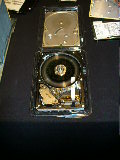
This effect can be seen in our photos, with the remains of the magnetic coating now present on a piece paper inserted into the drive chassis, exposing the clear glass platter.
It could be said this type of failure gives new meaning to “your data is now a pile of dust’.
The main issue, that of excessive dwelling was somewhat fixed by a firmware update meant for IBM supplied OEM disk drives that were used in IBM branded computers.
This update specifically addressed the excessive dwelling however we think it came too late to change the situation at hand. This update was not documented or advertised widely as it was meant to fix a specific issue that not all users would encounter.
Additionally since these disk drives were made available only via the Original Equipment Manufacturer or IT Distribution channel and not retail as is typically the case with hard disks there was no direct need to supply a fix for an issue that would be handled by official warranty process or changes to manufacturing of the devices. The OEM or system builder would be responsible, the first point of contact for support or warranty issues.
NitroWare.net has found that PC chassis that is sufficiently cooled helps prolong the life of these drives and avoids failure.
In 2008, these drives are now old, significantly slower than contemporary hard drives, (about a 1/3 of the performance) and their age, nearly ten years for the older examples represents a potential risk to data simply due to wear and tear and old age of drive especially if it heavily used.
If you still use one of these drives, we recommend replacing it as soon as possible for specifically the reason that the drives are now old and your data is worth more than a $100 Hard Disk Drive. You don’t have to dispose of the drive if it is still operational, and with the firmware update it can keep running – just do not rely on using an older drive as the only storage medium for essential files.
While the IBM Deskstar is long gone from the market, Data recovery firms still see these drives from time to time and users still lament about their failure. This is not the end of the story and the IBM Deskstar is, was not and will never be the ‘worst drive’ in history, nor will any other drive no matter of what their failure record is.
There have been other drives over the years since those drives that have experienced some higher than normal failure rates at specific points in time, such as the Seagate Momentus 5400.2 just to name one example.
There never will be a ‘worst drive ever’ as the technology used in magnetic hard drives is inherently flawed and can not be relied upon for long term archival storage.
A user, administrator or system builder will know whether a particular Hard Disk Drive will go the distance if survives the first six months of a drive. This period of time is the most risky period of owning a brand new Hard Disk Drive.
Verdict and a sensible, affordable way to preserve your data
In our meeting with Xyber Data recovery, the strategy that was we both agreed on is that since the cost to the user of brand new drives is so low compared to previous years, that for solid data integrity and security two drives should be purchased, with the second drive containing a backup mirror of the contents of the second and this drive should be stored securely away from a computer except for periodically running the drive and refreshing the contents of the drive.
This process helps eliminate the possibly of the read/write heads inside the Hard Disk Drive from sticking to the disk platter, an issue that is prevalent especially with drives in smaller form factors as the heads are physically smaller and more likely to stick but this issue is not as common as it once was. Running a spare drive occasionally reduces the possibility of this scenario.
We noticed the firm’s interesting slogan on some promotional material that was being distributed :
“You did backup today, didn’t you?”
This statement more than true and even the most hardened and battle scared IT administrator, system builder or user would be guilty of ignoring this statement.
As our role as an advocate for users, Hard Disk Drive technology/quality/reliability is an interest area of ours because it is an important one. The world is storing their lives and history digitally on storage media especially Hard Disk Drives.
We remind our readers that there never will be a ‘worst drive ever’ as the technology used in magnetic hard drives is inherently flawed and can not be relied upon for long term archival storage.
The national archives of the world have recognised this and begun research into the best strategy to manage their long term archival Hard Disk Drives that are in secure storage, even Google commissioned a study into their own internal hard disk failure rates.
In our research and interaction with the user community we have noticed a way too common trend of users not copying their data, but moving it between drives, and loosing it quickly after due to hardware failure.
As mentioned previously in our article approximate prices of large capacity Hard Disk Drives are now $100 AUD and not the $500 they once were; Blank CD/DVDs are 50 cents and Flash media like USB sticks and SD cards are $15 AUD.
While time may be still a valid excuse to ignore the integrity of your data, cost is no longer an excuse.
What are your memories, work and entertainment worth to you?
Make Multiple Copies Of Your Important Files
We cannot emphasise this enough.
Further Reading
Hitachi Global Storage Technologies – Travelstar C4K60
Hitachi Global Storage Technologies – Travelstar 80GN
Seagate Technologies - Seagate Barracuda 7200.9
http://apextechnology.co.uk/hard-disk-drive-repair-data-recovery-seagate.asp
http://www.impediment.com/seagate/seagate_disk_data.html
